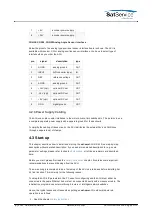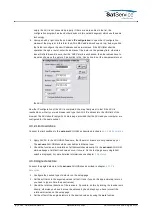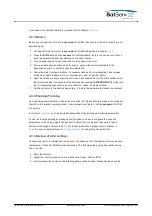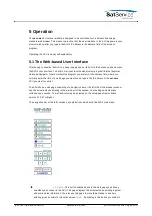
Date / time
By changing this value you can set the internal clock of the ACU. The clock is
set as soon you click to the 'Submit' button in the data entry dialog. The most
precise method to set the time is to enter a time one or two minutes ahead
and click to 'Submit' when this time is reached.
RS485
address
With this parameter you select the device address used control the ACU
through a serial interface. See chapter
7.3 The RS232 remote control
interface
for more information about this. At ACU-RMU and ACU19 this
parameter has to be set to 'NONE'. If you use a sat-nms Handheld this
parameter has to be set to 'TERM'. The Handheld function is not implemented
in ACU-RMU and ACU19 Version.
Watchdog
pulse on
AUX8
The AUX 8 output may be configured to act as a heartbeat output. If enabled,
the output switches every 1000 ms between on/off. If using this signal for an
external watchdog circuit, be aware that in adaptive tracking mode delays of
some seconds are possible while the acu calculates the orbital model.
Display
refresh
With this parameter you select the refresh-rate of the ACU's main window.
This parameter is available from software version 2.1.007 or higher.
Note
The ACU's pointing page by default shows the title 'Antenna pointing'. By
entering a different text here, you can make the ACU show a customized title.
Azimuth / Elevation / Polarization
The Azimuth / Elevation / Polarization sections contains the parameters which are specific to the
individual axis. They are the same for each axis.
Parameter Name --- Description
Antenna diameter --- Set this parameter to the dish diameter. Units with the tracking function
installed use this value to estimate some tracking parameters. With offset antennas, the
diameter settings are different for the azimuth / elevation axes. This lets the ACU calculate
suitable tracking step sizes individually for each axis.
Step delta --- This parameter defines size of a step the antenna moves when you click to the
arrow buttons on the ACU main page. If you are using the arrow buttons to fine-tune the
antenna pointing manually, the best value is the pointing hysteresis described below. This
lets you move the antenna the smallest possible step when you click to an arrow button. For
special applications however it might be helpful to set the step delta to a much greater value.
Position sensor type --- With this parameter you set the type of position sensor the ACU shall
read for this axis. Principally, the ACU is capable to read SSI, RESOLVER and ANALOG type
position sensors. The selected sensor type must match the type of interface board installed
in your ACU. It is not possible to switch from SSI to RESOLVER or vice versa without
changing the interface module.When selecting a SSI type position encoder, also the number
of bits and the encoding scheme must be selected. For the position sensor type parameter
these values are combined to one name. E.g. 'SSI-13G' means 13 bit, Graycode SSI sensor,
'SSI-24B' means 24 bit binary encoded SSI sensor.Beside the SSI-xxX, RESOLVER and
ANALOG selections this parameter offers the choice 'NONE' which tells the ACU not to read a
position encoder at all. With this selection you can tell the ACU if the polarization is not to be
controlled by the ACU.If you are using multiturn SSI encoders you will have to scale the
reading (See 'Calibration scale' below).
Pre scale offset --- The pre-scale calibration offset is added to the raw position encoder
reading before scaling is applied. The pre scale offset is defined as an 8-digit hexadecimal
value in normalized position encoder ticks (00000000-FFFFFFFF equivalent to the full range
(C) 2022, SatService GmbH
www.satnms.com
ACU-ODM-UM-2209 Page 35/73
















































